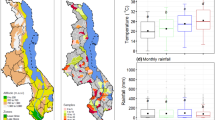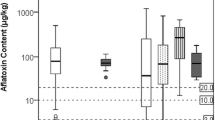Abstract
We report an unusual aflatoxin profile in maize and groundnuts from Malawi, with aflatoxin G1 found routinely at equal or even higher levels than aflatoxin B1. Aflatoxin B1 (AFB1) ratio in a contaminated sample is generally greater than 50 % of total aflatoxin (sum of aflatoxin B1, B2, G1, and G2). In Malawi, the aflatoxin occurrence ratios were determined by examining LC-MS/MS and HPLC fluorescence detection (FLD) data of 156 naturally contaminated raw maize and 80 groundnut samples collected in 2011 and 2012. Results showed that natural aflatoxin occurrence ratio differed. In 47 % of the samples, the concentration of AFG1 was higher than that of AFB1. The mean concentration percentages of AFB1/AFB2/AFG1/AFG2 in reference to total aflatoxins were found to be 47:5:43:5 %, respectively. The AFG1 and AFB1 50/50 trend was observed in maize and groundnuts and was consistent for samples collected in both years. If the AFB1 measurement was used to check compliance of total aflatoxin regulatory limit set at 10, 20, 100, and 200 μg/kg with an assumption that AFB1 ≥ 50 % of the total aflatoxin content, 8, 13, 24, and 26 % false negative rates would have occurred respectively. It is therefore important for legislation to consider total aflatoxins rather than AFB1 alone.




Similar content being viewed by others
References
Adetunji M, Atanda O, Ezekiel CN, Sulyok M, Warth B, Beltrán E, Krska R, Obadina O, Bakare A, Chilaka CA (2014) Fungal and bacterial metabolites of stored maize (Zea mays, L.) from five agro-ecological zones of Nigeria. Mycotoxin Res. doi:10.1007/s12550-014-0194-2
Ardic M, Karakaya Y, Atasever M, Durmaz H (2008) Determination of aflatoxin B1 levels in deep-red ground pepper (isot) using immunoaffinity column combined with ELISA. Food Chem Toxicol 46:1596–1599
Bennett JW, Goldblatt LA (1973) The isolation of mutants of Aspergillus flavus and A. parasiticus with altered aflatoxin producing ability. Sabouraudia 11:235–241
Bhatnagar D, McCormick SP, Lee LS, Hill RA (1987) Identification of O-methylsterigmatocystin as an aflatoxin B1 and G1 precursor in Aspergillus parasiticus. Appl Environ Microbiol 53:1028–1033
Carbone I, Jakobek JL, Ramirez-Prado JH, Horn BW (2007) Recombination, balancing selection and adaptive evolution in the aflatoxin gene cluster of Aspergillus parasiticus. Mol Ecol 16:4401–4417
Doster MA, Cotty PJ, Michailides TJ (2009) Description of a distinctive aflatoxin-producing strain of Aspergillus nomius that produces submerged sclerotia. Mycopathologia 168: 193–201
Ehrlich KC, Yu J (2009) Aflatoxin-like gene clusters and how they evolved. In: Rai M, Varma A (eds) Mycotoxins in food, feed and bioweapons. Springer-Verlag, Berlin and Heidelberg, Germany, pp 65–75
European Commission (EC) (2002) Commission Decision 2002/657/EC of 12 August 2002 implementing Council Directive 96/23/EC concerning the performance of analytical methods and the interpretation of results, as amended by Decision 2003/181/EC (4). Off J Eur Communities L 221:8–36
European Commission (EC) (2012) Regulation (EU) No 1058/2012 of 12 November 2012 amending Regulation (EC) No 1881/2006 as regards maximum levels for aflatoxins in dried figs. Off J Eur Union L 313:14–15
FAO (2004) Food Agriculture Organization of the United Nations, Food and Nutrition Paper No. 81: Worldwide Regulations for Mycotoxins in Food and Feed in 2003. Rome, Italy, p 165
Ghiasian SA, Shephard GS, Yazdanpanah H (2011) Natural occurrence of aflatoxins from maize in Iran. Mycopathologia 172(2):153–160
Haryadi Y, Setiastuty E (1994) Characterization of aflatoxin B1, B2, G1, and G2 in groundnuts and groundnuts products. In: Highley E, Wright EJ, Banks HJ, Champ BR (eds) Stored Product Protection. Proceedings of the 6th International Working Conference on Stored-Product Protection, 17–23 April 1994, Canberra, Australia (Wallingford UK, CAB International). University Press, Cambridge
Horn BW (1997) Aspergillus caelatus, a new species in section Flavi. Mycotaxon 61:185–191
Horn BW, Dorner JW (1998) Soil populations of Aspergillus species from section Flavi along a transect through peanut-growing regions of the United States. Mycologia 90:767–776
Horn BW, Greene RL, Sobolev VS, Dorner JW, Powell JH, Layton RC (1996) Association of morphology and mycotoxin production with vegetative compatibility groups in Aspergillus flavus, A. parasiticus, and A. tamarii. Mycologia 88:574–587
International Agency for Research on Cancer (IARC) (1993) Some naturally occurring substances: food items and constituents, heterocyclic aromatic amines and mycotoxins. In IARC monographs on the evaluation of the carcinogenic risks to humans, vol 56. IARC Press, Lyon
Ito Y, Peterson SW, Wicklow DT, Goto T (2001) Aspergillus pseudotamarii, a new aflatoxin producing species in Aspergillus section Flavi. Mycol Res 105:233–239
Kensler TW, Roebuck BD, Wogan GN, Groopman JD (2011) Aflatoxin: a 50-year odyssey of mechanistic and translational toxicology. J Toxicol Sci 120:S28–S48
Lee NA, Wang S, Allan RD, Kennedy IR (2004) A rapid aflatoxin B1 ELISA: development and validation with reduced matrix effects for peanuts, corn, pistachio and soybeans. J Agric Food Chem 52:2746–2755
Lin YC, Ayres JC, Koehler PE (1980) Influence of temperature cycling on the production of aflatoxins B1 and G1 by Aspergillus parasiticus. Appl Environ Microbiol 40:333–336
Malachova A, Sulyok M, Beltrán E, Berthiller F, Krska R (2014). Optimization and validation of a quantitative liquid chromatography–tandem mass spectrometric method covering 295 bacterial and fungal metabolites including all regulated mycotoxins in four model food matrices. Journal of Chromatography A. doi:10.1016/j.chroma.2014.08.037
Matumba L, Monjerezi M, Van Poucke C, Biswick T, Mwatseteza J, De Saeger S (2013) Evaluation of bright greenish yellow fluorescence (BGYF) test as a screening technique for aflatoxin contaminated maize in Malawi. World Mycotoxin J 6(4):367–373
Matumba L, Monjerezi M, Biswick T, Mwatseteza J, Makumba W, Kamangira D, Mtukuso A (2014a) A survey of the incidence and level of aflatoxin contamination in a range of locally and imported processed foods on Malawian retail market. Food Control 39: 87–91
Matumba L, Sulyok M, Monjerezi M, Biswick, Krska R (2014b) Fungal metabolites diversity in maize and associated human dietary exposures relate to micro-climatic patterns in Malawi. World Mycotoxin J doi:10.3920/WMJ2014.1773
Monyo ES, Njoroge SMC, Coe R, Osiru M, Madinda F, Waliyar F, Thakur P, Chilunjika T, Anitha S (2012) Occurrence and distribution of aflatoxin contamination in groundnuts (Arachis hypogaea L) and population density of aflatoxigenic Aspergilli in Malawi. Crop Prot 42:149–155
Oliveira C, Goncalves N, Rosim R, Fernandes A (2009) Determination of aflatoxins in peanut products in the northeast region of Sao Paulo, Brazil. Int J Mol Sci 10:174–183
Olsen M, Johnsson P, Moller T, Paladino R, Lindblad M (2008) Aspergillus nomius, an important aflatoxin producer in Brazil nuts? World Mycotoxin J 2:123–126
Peterson SW, Ito Y, Horn BW, Goto T (2001) Aspergillus bombycis, a new aflatoxigenic species and genetic variation in its sibling species, A. nomius. Mycologia 93:689–703
Pildain MB, Frisvad JC, Vaamonde G, Cabral D, Varga J, Samson RA (2008) Two novel aflatoxin-producing Aspergillus species from Argentinean peanuts. Int J Syst Evol Microbiol 58:725–735
Schmidt-Heydt M, Rüfer CE, Abdel-Hadi A, Magan N, Geisen R (2010) The production of aflatoxin B1 or G1 by Aspergillus parasiticus at various combinations of temperature and water activity is related to the ratio of aflS to aflR expression. Mycotoxin Res 26:241–246
Tran-Dinh N, Pitt JI, Carter DA (1999) Molecular genotype analysis of natural toxigenic and nontoxigenic isolates of Aspergillus flavus and A. parasiticus. Mycol Res 103:1485–1490
Van Egmond HP, Jonker MA (2004) Worldwide regulations on aflatoxins – the situation in 2002. Toxin Rev 23:273–293
Varga J, Frisvad JC, Samson RA (2009) A reappraisal of fungi producing aflatoxin. World Mycotoxin J 2:263–277
Varga J, Frisvad JC, Samson RA (2012) Two new aflatoxin producing species, and an overview of Aspergillus section Flavi. Stud Mycol 69:57–80
Warth B, Parich A, Atehnkeng J, Bandyopadhyay R, Schuhmacher R, Sulyok M, Krska R (2012) Quantitation of mycotoxins in food and feed from Burkina Faso and Mozambique using a modern LC-MS/MS multitoxin method. J Agric Food Chem 60:9352–9363
Wilson DM, King JK (1995) Production of aflatoxins B1, B2, G1, and G2 in pure and mixed cultures of Aspergillus parasiticus and Aspergillus flavus. Food Addit Contam 12:521–525
Yabe K, Nakajima H (2004) Enzyme reactions and genes in aflatoxin biosynthesis. Appl Microbiol Biotechnol 64:745–755
Yabe K, Ando Y, Hamasaki T (1988) Biosynthetic relationship among aflatoxins B1, B2, G1, and G2. Appl Environ Microbiol 54:2101–2106
Yabe K, Nakamura M, Hamasaki T (1999) Enzymatic formation of G-group aflatoxins and biosynthetic relationship between G- and B-group aflatoxins. Appl Environ Microbiol 65:3867–3872
Yabe K, Chihaya N, Hamamatsu S, Sakuno E, Hamasaki T, Nakajima H, Bennett JW (2003) Enzymatic conversion of averufin to hydroxyversicolorone and elucidation of a novel metabolic grid involved in aflatoxin biosynthesis. Appl Environ Microbiol 69:66–73
Younis YMH, Malik KM (2003) TLC and HPLC assays of aflatoxin contamination in Sudanese peanuts and peanut products. Kuwait J Sci Eng 30:79–94
Yu J, Chang P-K, Ehrlich KC, Cary JW, Bhatnagar D, Cleveland TE, Payne GA, Linz JE, Woloshuk CP, Bennett JW (2004) Clustered pathway genes in aflatoxin biosynthesis. Appl Environ Microbiol 70:1253–1262
Yu FY, Gribas AV, Vdovenko MM, Sakharov IY (2013) Development of ultrasensitive direct chemiluminescent enzyme immunoassay for determination of aflatoxin B1 in food products. Talanta 107:25–29
Acknowledgments
The authors are grateful for the following: (1) the Federal Country Lower Austria and the European regional development fund of the European Union for the LC-MS/MS system at IFA-Tulln; (2) the donation of HPLC system and starter-park reagents by EU to the Dept. of Agricultural Research Services (Malawi) through a SADC-Food Safety Capacity Building on Residues Control Project; (3) the Republic of Malawi (Ministry of Agriculture and Food Security), the World Bank, and the Norwegian Ministry of Foreign Affairs for co-financing the first author’s travel costs and living expenses abroad; (4) Prof. Dr. Maurice Monjerezi of the University of Malawi for kindly designing a map depicting sampling sites; and (5) invaluable technical assistance provided by L. Singano, T. Mhango, H. Mbalame, C. Gadaga, D. Kalima, D. Bwanamiri, M. Kalitsiro, C. Tchuwa
Conflict of interest
The authors declare that there is no conflict of interest.
Author information
Authors and Affiliations
Corresponding author
Rights and permissions
About this article
Cite this article
Matumba, L., Sulyok, M., Njoroge, S.M.C. et al. Uncommon occurrence ratios of aflatoxin B1, B2, G1, and G2 in maize and groundnuts from Malawi. Mycotoxin Res 31, 57–62 (2015). https://doi.org/10.1007/s12550-014-0209-z
Received:
Revised:
Accepted:
Published:
Issue Date:
DOI: https://doi.org/10.1007/s12550-014-0209-z




